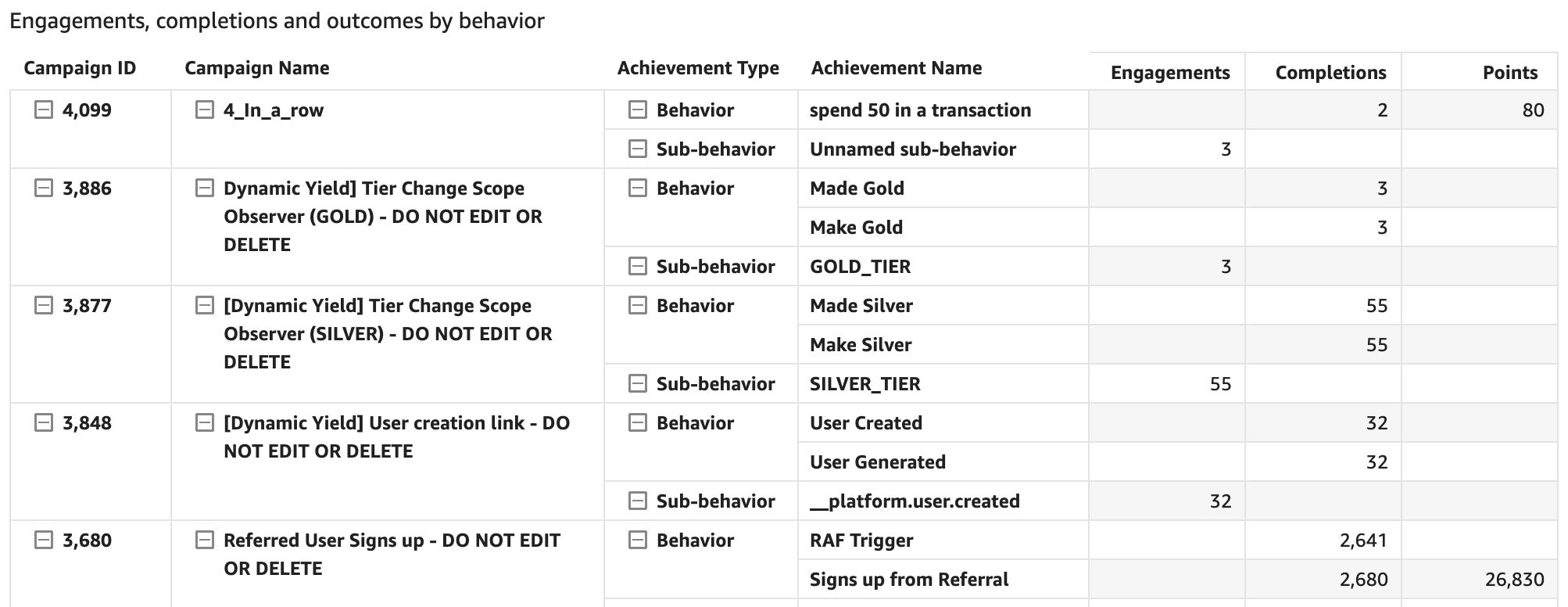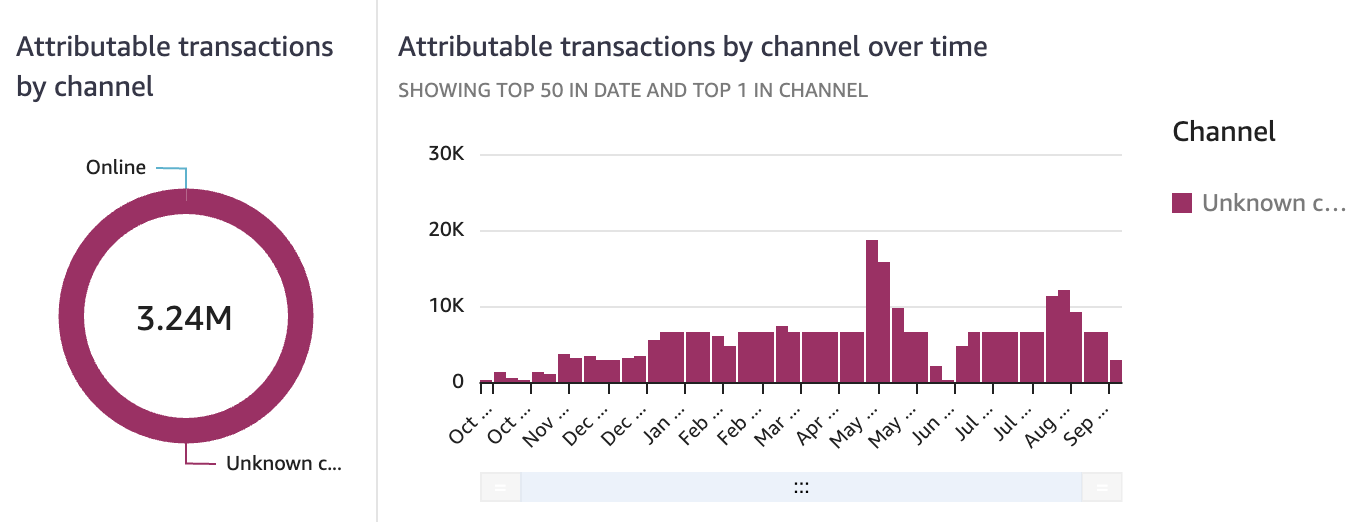What information does the Campaigns tab report?
The Campaigns tab provides interactive visualizations about campaign performance. In this tab, you can find details regarding a campaign’s setup and audience engagement.
-
Engagements over time, completions over time, and points awarded over time
-
Attributable transactions by channel and attributable transactions by channel over time
For information on the actions you can perform on the visualizations and key performance indicators (KPIs), see Common operations.
Filtering controls for campaigns
In general, deleted or draft campaigns are filtered out to minimize the clutter in the displayed list of campaigns. Filtering controls are available at the top of the tab, including campaign name, status, type and date ranges, as shown below:

Expand the controls by clicking on a single control or by clicking the arrow on the far right.

Use the controls to focus on particular areas of interest.
-
Campaign name allows you to toggle which campaign’s details are visualized. A value must first be selected to see a specific campaign’s details. By default, it shows all campaigns.
-
Campaign status allows you to select campaigns that are currently live, have been completed, or both. By default, it shows both live and completed campaigns.
-
Campaign type allows you to toggle the type of campaign to be visualized (for example, messaging or promotion). By default, it shows all campaign types.
-
Date between is a date picker that allows you to select the range of dates within which the displayed data is aggregated. Indicators are updated to aggregate data for only the selected period, while charts have their date ranges adapted to the selection. By default, it shows data for the past two years.
Engagements, completions and outcomes by behavior
This visualization reports all unique engagements, completions and total points issued for each behavior set up for a campaign.

The visualization has the following attributes:
-
Group ID and Campaign Name associated with a set of behaviors and sub-behaviors.
-
Achievement Type is either:
-
Behavior Type: Main objectives of a campaign (for example, purchase any eligible summer clothing item), which are often tied to an outcome like points or an offer issuance.
-
Sub-behavior Type: Sub-objectives, or rules, associated with a behavior. If the behavior is to purchase any eligible summer clothing item, then the sub-behaviors might be Item must be at least $50 or more, or Purchased item must belong to summer clothing catalog.
-
-
Achievement Name: Name of behavior or sub-behavior.
-
Engagements: Any interaction with a sub-behavior, but not necessarily a completion. Engagements are only associated with sub-behaviors.
-
Completions: When all sub-behaviors associated with a behavior are cleared. Completions are only considered for behaviors.
-
Points: Points awarded for completion of behavior based on campaign configuration.
The visualization attributes are expressed in KPIs, which are shown and detailed in the sections below.
Engagements over time, completions over time, and points awarded over time
These KPIs show a timeline trend view of engagements and completions.

The continuous line shown towards the top of the graph is the cumulative total. The bars in the graph depict the behavior or sub-behavior associated with the engagement or completion. This section provides a static and dynamic view of some key areas of purchase behavior.
Points awarded over time are grouped by behaviors associated with completions.
Attributable transactions by channel and attributable transactions by channel over time
These visuals report transactional performance associated with a campaign based on transaction channels. This section provides a static and dynamic view of some key areas of purchase behavior.
Attributable metrics - a few of which are shown below - only consider transactions within the campaign period that interacted with a campaign’s rules and observed behaviors. Transactions that do not are considered unattributable. For instance, if a campaign awards 100 points for any transaction that includes either a red or blue shirt, all transactions that contain a red or blue shirt would be considered attributable, while all other transactions are considered unattributable.

Tracker
Use the Tracker - shown below with a subset of its columns - to compare high-level KPIs across all campaigns so that you can identify the most successful ones. KPIs include:
-
Campaign details: Campaign ID and name, current status, category and start & end dates.
-
Active duration: Total days for which a campaign was active, that is, from start date to either end date (completed campaigns), the current date (live campaigns) or suspension date (suspended campaigns). If a campaign is suspended, then reactivated, the suspended days are not deducted from the total active days.
-
Engagement, including unique engagements and unique completions: Unique metrics are a count of distinct members that have interacted with a campaign.
-
Points awarded: Total amount of points issued for behavior completions associated with the campaign.
-
Attributable unique purchasers: Count of distinct members that have made a purchase that can be attributed to a campaign.
-
Completions per engagement: Ratio of engagements that resulted in a completion.
-
Average days to completion: Average number of days members take between the first engagement with a campaign to its completion.
![]()